A Successful
Trouton-Noble experiment
by Jean-Louis Naudin and Patrick
Cornille
Created on 04-28-98 - JLN Labs - Last
update 02-16-99
The Trouton-Noble experiment was intended
to detect the motion of
the earth through the aether:
When a freely suspended parallel plate
capacitor is charged at high voltage, it turns
"spontaneously" so as to minimize its total energy, and
seek a stable position parallel
to the direction of the motion of the earth in the aether (the
Zero Point Field).
1. WHY IT FAILS
The Trouton Noble (1) experiment is generally regarded
as the electrostatic equivalent of the Michelson-Morley optical
experiment: it looks for an effect predicted to be caused by the
absolute motion of the Earth through the ether. If a parallel
plate capacitor is suspended by means of a fine torsion fibber
and charged, an electromagnetic torque is expected due to
magnetic forces since the capacitor is moving through the ether.
Specifically, the torque  should be
should be  where Q is the charge of the
capacitor, D the distance between the capacitor plates, U the
velocity of the capacitor carried along by the Earth in its
absolute motion in space, q the angle between the velocity vector
and the normal to the capacitor plates and j the angle between
the velocity vector and the fibber. The original Trouton-Noble
experiment looked for the effect due to the orbital velocity U =
3x106 cm/s of Earth about the Sun. It found a null
result. However, Chase (2) identified experimental problems
making the original Trouton-Noble null result inconclusive. Chase
repeated the experiment without the identified sources of error,
and found the same null result. More recently, Hayden (3)
designed an experiment which is 105 times more
sensitive than the original Trouton-Noble experiment, and that
also yielded a null result.
where Q is the charge of the
capacitor, D the distance between the capacitor plates, U the
velocity of the capacitor carried along by the Earth in its
absolute motion in space, q the angle between the velocity vector
and the normal to the capacitor plates and j the angle between
the velocity vector and the fibber. The original Trouton-Noble
experiment looked for the effect due to the orbital velocity U =
3x106 cm/s of Earth about the Sun. It found a null
result. However, Chase (2) identified experimental problems
making the original Trouton-Noble null result inconclusive. Chase
repeated the experiment without the identified sources of error,
and found the same null result. More recently, Hayden (3)
designed an experiment which is 105 times more
sensitive than the original Trouton-Noble experiment, and that
also yielded a null result.
There is a fallacy in the usual reasoning about the Trouton-Noble
experiment. It is wrong to neglect the torque due to the forces
exerted by the insulating separators necessary to keep the plates
from approaching each other under their mutual electric
attraction. Therefore the torque must not be obtained by
calculating the interaction between the charges of the plates
which face one another, but instead by calculating the
interaction between the charges of the plates symmetric with
respect to the axis of symmetry of the capacitor as shown in
Fig.1. For a symmetric and homogeneous distribution of charges on
the plates, the total torque must be zero at low voltage. Thus
the capacitor is in equilibrium under both the electromagnetic
and the mechanical forces of constraint exerted by the rods for
all orientations of the capacitor.
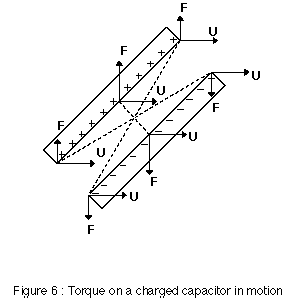
2. WHY IT SUCCEEDS
Hayden (4) recently offered an analysis of the Trouton-Noble
experiment in which he concluded that it is not competent to
decide about the existence of the luminiferous ether. But I will
argue here that the Trouton-Noble effect can indeed be observed,
under the proper conditions.
As discussed in recent papers (5-14), any stimulated motion
either rectilinear or rotational of a charged capacitor located
in the Earth's reference frame is a consequence of the violation
of Newton's third principle. We can show that the effect is small
or zero if the charges on the surfaces of the plates are the only
charges which participate to the effect. However, the charges
inside the plates can give a more important contribution to the
predicted effect provided one uses a voltage higher than 40 kV.
Therefore, the Trouton-Noble experiment previously failed because
the voltages of 2 or 0.6 kV used in the experiments were too
small and also because there is no leakage current in the
capacitor which is necessary to increase the magnitude of the
stimulated rotation.
An experiment showing the linear stimulated motion of the
capacitor through the ether has been reported elsewhere
(7,9,11,13). However, we would like to report that the stimulated
rotation of a parallel plate capacitor has also been observed.
The parallel plate capacitor was obtained by sticking two thin
aluminum foils to an insulating plate which was suspended by a
thin wire to the ceiling of the laboratory. As soon as the
voltage increases, one can see the torque effect.
3. REFERENCES
1) F. T. Trouton and H. R. Noble, The forces acting on a charged
condenser moving through space, Proceedings of the Royal Society,
Vol. 72, p. 132, (1903)
2) C. T. Chase, A repetition of the Trouton-Noble ether drift
experiment, Phys. Review, Vol. 28, p. 378, (1926)
3) H. C. Hayden, High sensitivity Trouton-Noble experiment,
Review Scientific Instruments, Vol. 65, N° 4, p. 788, (1994)
4) H. C. Hayden, Analysis of Trouton-Noble experiment, Galilean
Electrod., Vol. 5, N° 4, p. 83, (1994)
5) P. Cornille, The Lorentz force and Newton's third principle,
Can. J. Physics, Vol. 73, N° 9 &10, p. 619, (1995)
6) P. Cornille, Derivation of the ether from anomalies in
Newton's third law, New Frontiers in Physics (Eds. T. L. Gill),
Hadronic Press, 1996
7) P. Cornille, Why Newton's third principle is the most
important principle in physics, International Conference:
Descartes and Scientific Thought 1596-1996 (Eds. U. Bartocci),
Perugia, 1996
8) P. Cornille, J.-L. Naudin and A. D. Szames, Way back to the
future: why did the Trouton-Noble experiment fail and how to make
it succeed, p. 81, Physical Interpretations of Relativity Theory
VI (Eds. M. C. Duffy), Imperial College, London: 11-14 September,
British Society for the Philosophy of Science, 1998
9) P. Cornille, Why free energy is mathematically and physically
possible, Infinite Energy, Vol. 4, N° 21, p. 50, (1998)
10) P. Cornille, Newton's third principle in post-Newtonian
physics-part I: theory, Gal. Electrodynamics, Vol. N° p. (1999)
The
Trouton-Noble replication (The First Run) by Jean-Louis Naudin on
04-28-98 :


Plexiglass sheet ( relative permitivity
= 4 ): size 250x210 mm and 2mm thick
aluminum sheets, size150x190mm
capacity = 505pF, at 70kV the energy
stored is 1.23 Joules
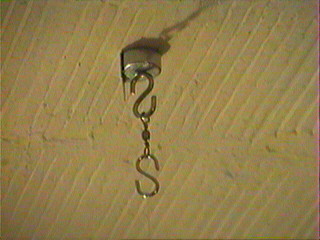
A detail of the suspension of the Trouton-Noble
capacitor
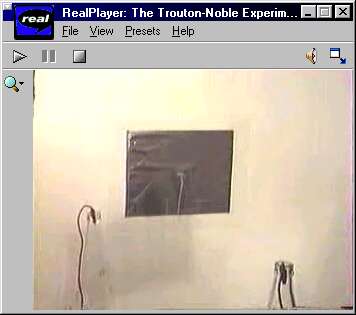
click here to see the T-N experiment
(04-28-98) video
(151k)
( if you don't have the RealPlayer 5.0, you
may download it freely at : http://www.real.com/products/player/
)
The
Trouton-Noble replication (Second Run) by Jean-Louis Naudin and
Patrick Cornille on 05-07-98 :
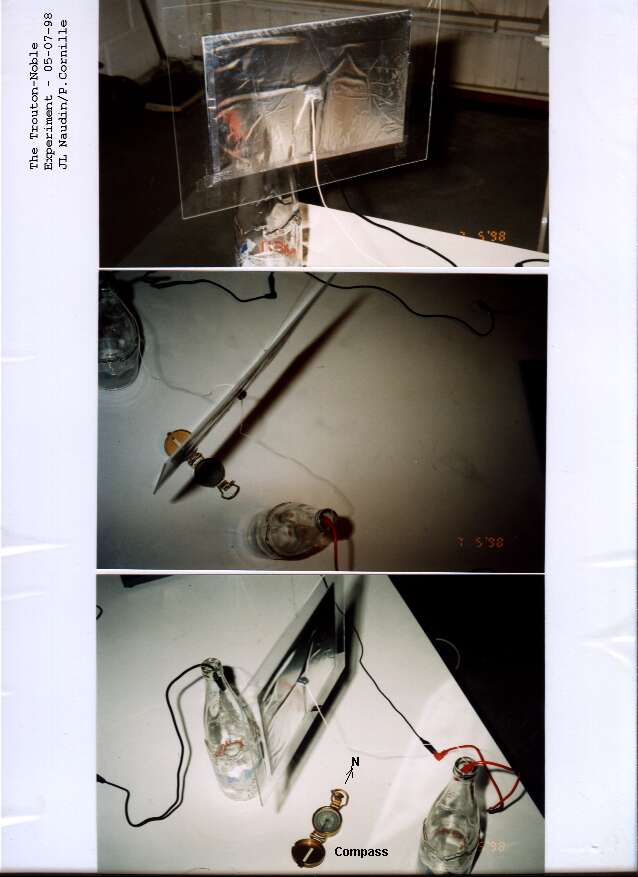
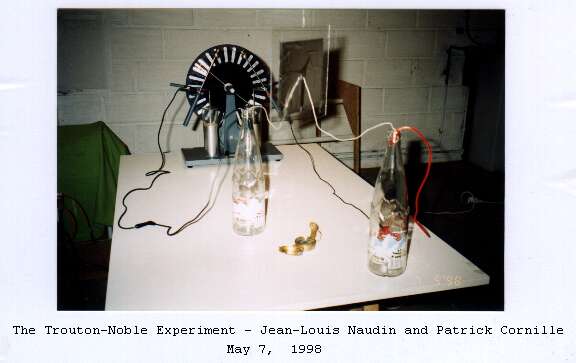
The
Trouton-Noble replication (Third Run) by Jean-Louis Naudin on
09-16-98 :

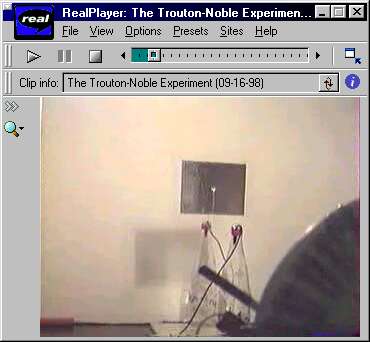
click here to see the T-N
experiment (09-16-98) video
(150k)
( if you don't have the RealPlayer 5.0, you
may download it freely at : http://www.real.com/products/player/
)
Notes:
The successfull replication of the Trouton-Noble experiment
conducted by Jean-Louis Naudin and Patrick Cornille has been
presented during the "Physical Interpretations of Relativity
Theory - VI conference" at the Imperial college in London
(UK) on September 12th, 1998.
You
may see also :The
Jean-Louis Naudin's
ZPF Motor v1.0, diagram and test
 Mail
to Mr Patrick Cornille
Mail
to Mr Patrick Cornille
Back to the Electrostatic Pendulum home page








